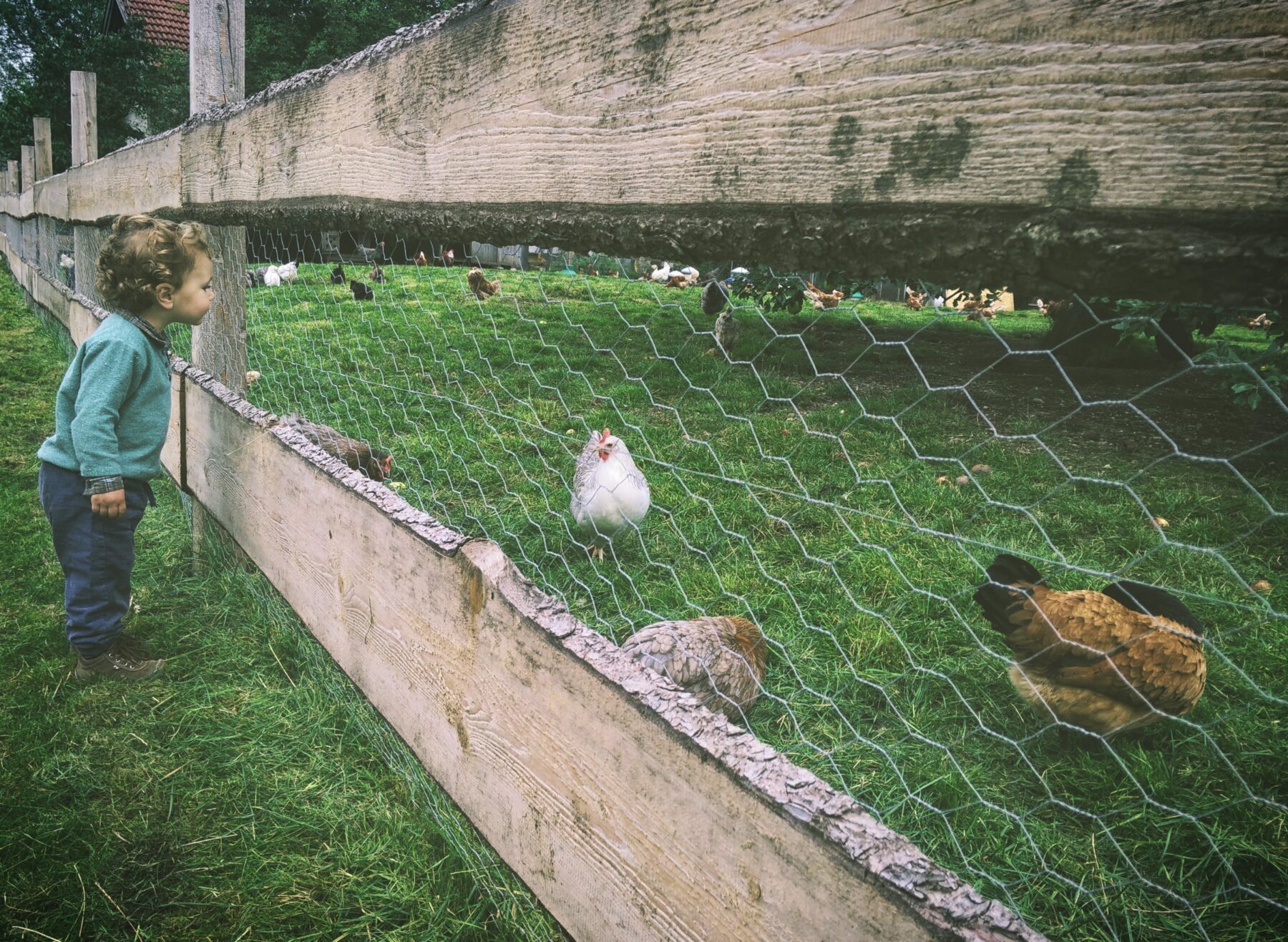My husband calls me “City Girl,” and that’s probably true, but I’m a country girl at heart. I enjoy dabbling in micro-scale farming adventures on my little slice of suburbia. Just over ten years ago, I began raising backyard chickens with four hens I adopted from a friend that was downsizing her flock. That little flock of four quickly ballooned to an excessively large flock of 51, until sanity prevailed and we settled for 12. When this eggcentric adventure began, I was totally clueless about how to raise chickens, but with access to the Internet and experienced friends, it didn’t take long to ramp up on the knowledge I would need. Starting a backyard flock is a bit more complex than bringing home a new puppy, but over the long haul, taking care of chickens — even 51 of them — is a lot easier than taking care of a puppy. Here’s my step-by-step guide to get started with a backyard flock.
Step 1: Research
The first thing you’ll need to do is check out local zoning regulations to determine if you are legally permitted to have livestock. A quick Internet search or a call to the local zoning office should provide the information you need. Also, If you are in a neighborhood with an HOA, it’s equally important to check on the community rules.
You should also check with your state’s Department of Agriculture to determine if you will need to apply for a license to keep these chicks on your property. This is particularly important because poultry are susceptible to viral infections that can spread very quickly. By knowing where all of the flocks are located within the state, the Department of Agriculture can provide you with the information you’ll need to protect your birds if there’s an outbreak.
Once you know if you are permitted to have chickens, how many you are legally able to keep, and have the required licensure, the next thing you’ll want to research is breeds. Some breeds, like Leghorns, are known for being extremely productive egg layers, often laying over 300 per year. Breeds like the Plymouth Rock are considered “dual purpose” hens because they are not only great layers, but they can also be raised for meat. There are also small and ornamental breeds, like bantams and silkies. A great way to find information is to search for “chicken hatcheries” online. Those websites often provide excellent information about the different varieties of laying hens and meat birds.
Step 2: Getting Ready
Like all animals, chickens have some basic requirements — shelter, food, and clean water. There are a few nuances to consider for chickens, but getting ready for a flock is a relatively straightforward process.
The first consideration is whether you plan to bring home baby chicks or full-grown hens. If you will be starting with baby chicks, you’ll need a brooder box and a heat lamp to keep them contained and warm until they are fully feathered. Those adorable little fuzz-balls will grow really fast, so they will only be in the brooder for about a month before being transferred to the permanent outdoor chicken coop.
Chicken coops run the gamut from small and basic to enormous and elaborate. Whenever possible it’s great to be able to repurpose existing and underused structures for your hen house. Old dog houses, children’s plastic playhouses, or old sheds are easily modified for chickens. A chicken house is stationary, so it’s best to locate it in a part of the yard that is far enough from the house to reduce the impact of squawking hens and the smells that go with them. Overcrowding will lead to more frequent problems with parasites, disease, coop cleanliness, and pecking order bullying issues, so be sure to give enough space.
Next, your chickens will need a run area. This is where the hens will spend their days scratching around looking for insects and fresh vegetation. They are so efficient in this endeavor that the entire run will be picked clean of all vegetation in just a few months. The run should be an enclosed, protected area, large enough that each hen has roughly ten square feet of space.
Your coop will need boxes about one foot by one foot, and it’s best if there’s some sort of divider between them — a lady needs some privacy after all. Some use milk crates, cardboard boxes, repurposed plastic storage bins, small pet carriers, large mixing bowls, and small plastic waste baskets. If you prefer, prefabricated plastic and metal nest boxes can be purchased online or at local farm supply stores.
Step 3: Food and Water
One of the beautiful things about chickens is that they can eat so many different things. If you have enough open space and can “free-range” your hens, you won’t have to spend as much money on feed. Hens love eating grass, vegetation (including your kitchen scraps and leftovers), and bugs. The more access they have to those kinds of natural foods, the healthier they will be and their eggs will also be more delicious and nutritious. Most chicken owners supplement with store-bought chicken feed. Younger chicks will require “Chick Starter” crumbles, while full-grown hens will need layer crumbles or pellets.
Clean water is essential to ensure that your flock stays healthy. Dirty water is one surefire way to spread disease in a flock. Plastic and metal waterers are relatively inexpensive and easy to keep clean. Be sure to have at least one waterer for every three or four hens.
Step 4: Purchasing Chicks
There are several ways to start your backyard flock. If you are really adventurous, you can purchase an egg incubator and purchase fertilized eggs from a hatchery or farmer. This method is really fun and a great educational opportunity but takes more time, and more work.
The most popular method for starting a flock is to order chicks from a hatchery, or purchase them at a local farm store. If ordering from a hatchery, you’ll have the option of “straight run” or “sexed” chicks. If you don’t want roosters, you’ll want to go with the “sexed” option. Of course, sexing a baby chick is more of an art than a science, so sometimes a rooster will be in the mix anyway.
The best way to ensure that you will only have hens is to purchase “pullets.” Pullets are young hens, not baby chicks. So, if you purchase pullets you will miss out on the delightful experience of playing with baby chicks, but you will know that all of the birds are female, and they will be closer to the age when they’ll begin to lay eggs. Pullets cost more than baby chicks, but you won’t have the expense of needing a brooder box and heat lamp, or the undesirable dilemma of figuring out what to do with a rooster.
More to Consider
While those four steps will get you ready to start your backyard flock, they really only scratch the surface in terms of the details of care. There’s a lot more to learn about biosecurity, protecting your flock, monitoring for illness, and dealing with challenges like broody hens and pecking order problems. Thankfully, the Internet has hundreds of blogs and videos that offer expertise and advice on just about every topic imaginable.
Before you take the leap, however, there are a couple of other things to consider. First, what is your primary motivation for wanting chickens? If that motivation is to add some feathered friends as family pets, and eggs are just an added benefit, then go for it. If, however, your primary goal is to have a source of fresh eggs, you should understand that egg production peaks during the first two years, but after that drops off pretty quickly. The average hen can live up to ten years. This natural dynamic means that at some point you’ll have to make a hard decision about what you will do with the hens that are no longer laying on a regular basis. Will you keep them anyway? Will you try to rehome them? Will you process them for meat? It won’t be an easy decision, so you really do need to think about that before you commit to having a flock.
The second consideration is that having chickens can impact your freedom to be away from home, especially in the evening. Chickens are very vulnerable to predators, so they need to be secured inside of the coop after dark and let out again in the morning. While they will naturally seek out shelter when the sun goes down, they can’t lock themselves inside, so that will be your job. If you will be away in the evening, you’ll need to arrange for a friend or neighbor to lock up the hens, otherwise, they will be left vulnerable to predators. Likewise, someone will need to be available every morning to let them out of the coop.
Despite those challenges, I’ve thoroughly enjoyed having chickens. The eggs are fantastic and unlike anything you’ll ever get at the grocery store. Those baskets of beautiful eggs also add at least a small degree of food security which is very desirable in the current economic climate. In addition, the droppings can be composted to make an excellent fertilizer for the garden,which is a great exercise in sustainability. Aside from those practical benefits, take it from this City Girl, chickens are just really fun to observe and interact with, so be prepared to get addicted.





 Copyright
2024
Root and Vine
Copyright
2024
Root and Vine